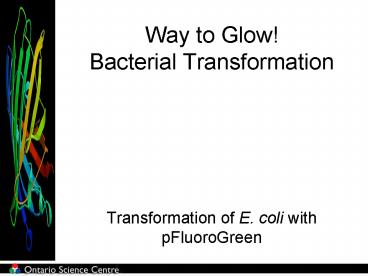Way to Glow! Bacterial Transformation - PowerPoint PPT Presentation
1 / 28
Title:
Way to Glow! Bacterial Transformation
Description:
Way to Glow! Bacterial Transformation Transformation of E. coli with pFluoroGreen What is our goal? To express green fluorescent protein (GFP) into transformed ... – PowerPoint PPT presentation
Number of Views:202
Avg rating:3.0/5.0
Title: Way to Glow! Bacterial Transformation
1
Way to Glow! Bacterial Transformation
- Transformation of E. coli with pFluoroGreen
2
What is our goal?
- To express green fluorescent protein (GFP) into
transformed bacterial cells
3
Laboratory Safety
- Gloves
- Goggles
- Lab coat
- Non-pathogenic strain of E. coli
4
Transformation of E. coli
- Label one microcentrifuge tube - DNA.
- Label 2nd microcentrifuge tube DNA.
Label on top of the lid
5
How to use a micropipette
- White Round Knob
- First Stop
- - to measure the desired amount of liquid
- Second Stop
- - to dispense all the of liquid and air in the
pipette tip - Tip Ejection Button
- - to eject pipette tip into waste container
6
Using a micropipette
CaCl2
- 3. Using a F250 micropipette, add 250 µl of ice
cold CaCl2 solution to each tube.
250 µl
250 µl
- DNA
DNA
7
Pick your colony
- Pick colonies from source plate of E. coli cells
- 5. Use a sterile loop to transfer several (3-4
colonies) from the source plate to DNA and DNA
tube - 6. Between your fingers, twist the loop
vigorously in the cold CaCl2 to dislodge the cells
8
Adding the plasmid
- 7. To the DNA tube add 10 µl pFG.
Add 10 µl pFG
DNA
9
Incubate on ice
- 8. Incubate tubes on ice for 10 min.
10
Bacterial DNA
Bacterial cell
Plasmid DNA
Genomic DNA
11
What is a plasmid?
- Circular piece of DNA
- Contain gene for GFP (Green Fluorescent Protein)
- Also has gene for Ampicillin resistance (AmpR)
- ori is the site where replication begins
12
What is transformation?
GFP
Ampicillin Resistance protein
- Uptake of foreign DNA (plasmid) by the bacterial
cell - Gives the bacterium a new genetic trait!
13
Bioluminescence
- Biochemical process
- Living organism gives off light
- Bacteria, fungi, worms, jellyfish, insects,
marine fish
14
Jellyfish GFP gene
- Bioluminescent jelly fish Aquorea victoria
natural host of green fluorescent protein (GFP) - GFP is produced in special photogenic cells in
the base of the jellyfish umbrella
15
Fluorescent proteins
- The jelly fish Aquorea victoria, produces a
photoprotein aequorin which interacts with the
GFP to produce green light - In the transformed E. coli cells, the GFP
fluoresces green only when exposed to long wave
UV light
16
Bacterial Transformation The real world
- Bioremediation
- Agriculture
- Medicine
17
Heat shock
- Place both tubes at
- 42C for 90 seconds.
- 10. Return tubes immediately to ice
- and incubate for
- 2 minutes.
18
Bacteria recovery
- 11. Using a sterile pipette, add 250 µl of Luria
Broth (LB) to each tube. Change tips. - 12. Incubate cells for 20 minutes in 37C dry
incubator for a recovery period.
19
Label agar plates
Amp/-DNA
Amp/DNA
Ref ? Grp
Ref ? Grp
- 13. Label two plates Amp/-DNA
- 14. Label the other two plates Amp/DNA
20
What happens in each transformation step?
- Transformation solution CaCl2
- Positive charge of Ca2 ions neutralizes
- cell membrane phospholipids
- negative charge of phosphate groups in DNA
- The Cl- ions move into the cell taking H2O
molecules with them, which causes the cell to
swell up.
21
What happens in the heat shock step?
- Creates a small convection current that causes
the plasmid to get pushed into the cell - Duration of heat shock is critical to
experimental success
22
What happens in the bacterial recovery step?
- What is LB?
- Luria-Bertani (LB) broth
- Made of yeast, enzymatic digest of meat products
- Medium that contains nutrients for bacterial
growth and gene expression - Carbohydrates
- Amino acids
- Nucleotides
- Salts
- Vitamins
- Allows cells to grow
23
Expected results
-DNA
DNA
CaCl2 E. coli LB
CaCl2 E. coli pFG LB
Growth Green glowing colonies
No growth No glowing colonies
By counting the number of colonies, you can
then calculate the transformation
efficiency Number of transformants X final
vol. at recovery Number of µg
of plasmid DNA vol. plated
transformants per µg
Amp/-DNA
Amp/DNA
24
How to plate cells
- 15. Remove the tubes from the dry bath incubator
- 16. Plate the cells as follows
-DNA
DNA
250 µl
250 µl
250 µl
250 µl
Amp/-DNA
Amp/-DNA
Amp/DNA
Amp/DNA
25
How to spread the cells
- 17. Spread the cells with a sterile inoculating
loop - 18. Cover both plates and allow the liquid to be
absorbed
Spread cells in 1 direction
Same plate spread cells 90 to first direction
26
Preparing plates for incubation
- 19. Stack your groups set of plates on top of
one another and tape them together - Keep plates in upright position
- 20. Wait for 24 hours!
- Plates will incubate at 37C in a bacterial
incubation oven
27
Clean up
- Bring the waste bins and plates to the front
- Put the pipettes, tips and microcentrifuge tube
box into the drawers (refer to the pic at the
back of the drawer) - Put the other things into the basket
- Wipe the table with Virox wipes
- Now you can remove your gloves and goggles
- Sanitize your hands with purell. Wash your hands
with soap after you leave - Return the lab coats
28
Thank you and goodbye!































